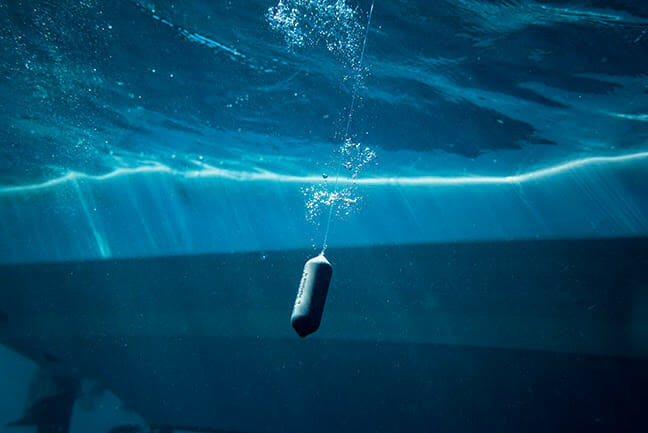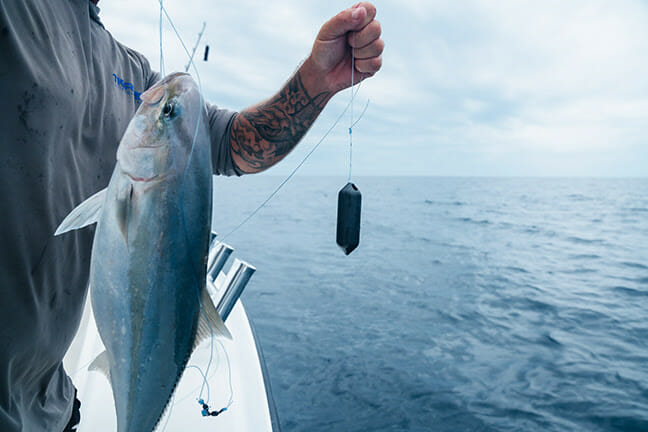
The world’s first and only shark deterrent device is out-performing expectations – and it couldn’t come sooner for veteran bottom bouncers pounding shark infested waters.
CHARLESTON, SC (May 13, 2021) – A lot of new devices and gadgets on the fishing front these days proclaim themselves to be cutting edge, ground-breaking or game changing. But only a few are. Still, every now and then a radically different product clearly rises above the fleet by providing a novel solution to a difficult problem, a new way of thinking, or breakthrough technology that clearly makes fishing more productive, environmentally friendly and down-right fun. Enter the Sharkbanz Zeppelin. The world’s first and only shark deterrent fishing tackle, it’s a new, science-based product that keeps one of nature’s most aggressive predators at bay, and it’s already winning acclaim from veteran bottom bouncers wherever sharks may roam.
“I’d call it revolutionary,” says Capt. Pat Price of Daymaker Charters in Stuart, Florida. “Around here, ‘getting sharked’ is a daily occurrence. There are just so many, they are unavoidable. Anglers end up sacrificing a lot of grouper, snapper, cobia and other fish to fill their limits. Some days sharks take 80% of the bottom species hooked. I’ve just finished a three-week trial with the Sharkbanz Zeppelin. When we first started, it reduced shark predation by about 70 percent overall. As we experimented with different ways to use it, we were able to bring that up to about 90-percent reduction. It works great!”

If the name Sharkbanz rings a bell, that shouldn’t come as a surprise. Recognized worldwide by surfers, swimmers, divers and beachgoers, the company already offers a wearable device, the Sharkbanz 2, that uses patented magnetic technology developed by marine biologists to deter predatory sharks with amazing consistency. The result of over a decade’s worth of research in the USA, Australia and South Africa on the efficacy of permanent magnets as a shark deterrent, this technology has also proven effective at deterring sharks in fishing applications, reveals Nathan Garrison, who cofounded the company with his father, David, in 2014.
“Based on our proven technology and testing success, we recently introduced the Sharkbanz Zeppelin” says Garrison. “Designed specifically for anglers, it’s compact, easy-to-use, requires no batteries or charging, and can be used as a sinker or tied into the main leader to help reduce the age-old problem of shark depredation, otherwise known in fishing circles as ‘Paying the Taxman.’”
The Sharkbanz Zeppelin is an outwardly simple, sleek, lightweight and durable device. There’s undoubtedly a lot of electromagnetic power packed into this 3.5-inch, 6.5-ounce shark deterring addition to your terminal tackle, but the key to its success really lies in shark physiology.
“Most people know sharks can detect tiny amounts of blood in the water from miles away, but that’s just one of several senses these predators use to home in on prey,” explains Davis Mersereau, Sharkbanz’s Director of Business Development. “Another is their amazing electroreception, which is the ability to detect minute electrical fields. In fact, they have an organ located right in the snout called Ampullae of Lorenzini that specializes in that purpose. Using this asset along with its lateral line and other senses, a shark can sense the erratic electrical impulses of stressed fish or other creatures and zero in from great distances, even at night or in murky waters where visibility is limited.
Just how sensitive is a shark’s electromagnetic perception? Mersereau quotes biologist R. W. Murray, in research published in Scientific American, as determining a shark’s electroreception organ can respond to fields as weak as one-millionth of a volt applied across a single centimeter of water. This effect is equivalent to the electrical current that would be produced in the sea by connecting a 1.5-volt AA battery with one pole dipped into New York’s Long Island Sound and another pole placed in the water off Jacksonville, FL. Theoretically, he says, a shark swimming between these two points could tell when the battery was switched on and off.

It’s precisely because a shark’s electroreception is so finely tuned that the Zeppelin sees such great results. By keeping its primary electromagnetic field controlled to a small, targeted area, it has no effect on other marine life, except for the shark’s close cousin, the stingray. It does not deter other fish species from taking a bait or striking a lure, yet when a shark comes close, the electromagnetic field overwhelms its senses, triggering a highly unpleasant sensation that causes the Taxman to veer off. This cause and effect can be likened to having a bright light suddenly shined in your eyes in a dark room. You wouldn’t be hurt, but you’d probably want to turn away.
No other tissue, organ or animal exhibits such extreme sensitivity to electricity, notes Mersereau. “Indeed, engineers have difficulty measuring such weak fields in seawater using modern equipment. Now that doesn’t mean a shark will come swimming up the coast in response to a tiny trickle of electrical current as if someone just rang the dinner bell. This is just an illustration. But it’s a chink in the shark armor that we can exploit to deter them from attacking people in the water or a hooked fish at the end of an angler’s line.”
To be clear, the Sharkbanz Zeppelin is based on solid science. More than a dozen studies referenced on the company’s website, demonstrate that permanent magnets project detectable magnetic fields underwater sufficient to elicit avoidance in a range of shark species including hammerhead, bull, white, Australian blacktip, lemon, grey reef, milk and speartooth. The company also maintains contact and collaborates with Dr. Eric Stroud and Dr. Patrick Rice, the founders of Shark Defense Technologies, the leaders in shark repellent technology.

“While our Zeppelin is unlikely to deter 100-percent of shark depredation,” says Garrison, “it will deflect most attacks aimed at taking a bite out of an angler’s catch. That’s a big deal because now you can fish right through the sharks and watch as they turn away just before zeroing in for the kill. In addition to saving your catch, the Sharkbanz Zeppelin prevents tackle loss, serves as a conservation tool to protect sharks from being hooked, and lessens the number of bottom fish needed to ice some tasty fillets. Looking forward, we will continue to be scientific and results-driven as we test and improve our products across a range of applications in recreational and commercial fishing through strategic research and development.”
Garrison, who first came up with the idea for Sharkbanz’ original shark deterrent technology after a friend was injured in a shark attack while surfing in the waters off Folly Beach, South Carolina, stresses positioning the Sharkbanz Zeppelin properly is vital to obtaining optimal results. “You need the device to sit 18- to 36 inches below the tail of your hooked target species. Most sharks follow a hooked fish toward the surface and attack from below, so the Zeppelin’s electromagnetic field needs to be placed between the shark and your catch to be effective. There’s a few different ways to do it – check out the Sharkbanz website and Instagram pages to see pro captains explain their methods.”

And how is the Zeppelin performing in real life bottom-fishing situations?
Capt. Billy Delph, of Delph Fishing Charters in Key West, Florida revealed that he was skeptical at first but actually achieved a 100% success rate in terms of deterring sharks on his final day of testing. “They just didn’t want to penetrate that electromagnetic barrier,” he said.
Even down under, the Zeppelin has performed admirably. Australian charter skipper Capt. Terry Maxwell, who sails out of Exmouth, also reports tremendous success using the Sharkbanz Zeppelin in shark-infested waters. “Without the Sharkbanz we were getting sharked right away. With the device, we’ve had nothing but success. Where I might lose 16 fish to sharks and bring home 14, now I’m losing three and filling my limit much faster. The Sharkbanz Zeppelin is a godsend that can help us keep our fisheries in sustainable condition.”
Which is exactly the point, reminds Garrison. “We’re trying to solve the problem of shark depredation in a way that respects these highly efficient predators, fish stocks and anglers so we can co-exist. I can’t wait to see the results as more anglers use our Zeppelin device. I really think it’s going to make a big difference in the long run.”
To see videos of the Sharkbanz Zeppelin deployed in shark infested waters, view studies that support Sharkbanz theory and technology, or order the Sharkbanz Zeppelin online now, visit: www.sharkbanz.com. The Sharkbanz Zeppelin will also be available at local tackle shops starting this June.
ABOUT Sharkbanz
Sharkbanz is the first wearable shark deterrent technology created by experienced ocean goers Nathan and David Garrison. Instead of waiting for the next attack to happen, they decided to do something about their underlying fear. After three years of testing, design, and development, the first version of Sharkbanz launched in 2015. Using patented magnetic technology with decades of research by marine biologists, Sharkbanz takes advantage of a shark’s unique and powerful electroreception to cause a highly unpleasant sensation that turns them away without harm. Their latest device, the Sharkbanz Zeppelin, uses the same groundbreaking technology to deter sharks from munching on angler’s catches being reeled to the surface. Sharkbanz pledges 3-percent of profits for ocean and shark conservation and aims to raise awareness on issues that impact the world’s oceans.









